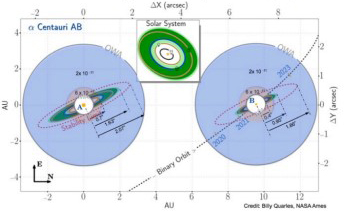Space telescope design to directly image the habitable zone of Alpha Centauri
Abstract
The scientific interest in directly image and identifying Earth-like planets within the Habitable Zone (HZ) around nearby stars is driving the design of specialized direct imaging mission such as ACESAT, EXO-C, EXO-S and AFTA-C. The inner edge of Alpha Cen A&B Habitable Zone is found at exceptionally large angular separations of 0.7” and 0.4” respectively. This enables direct imaging of the system with a 0.3m class telescope. Contrast ratios in the order of 1010 are needed to image Earth-brightness planets. Low-resolution (5-band) spectra of all planets, will allow establishing the presence and amount of an atmosphere. This star system configuration is optimal for a specialized small, and stable space telescope, that can achieve high-contrast but has limited resolution. This paper describes an innovative instrument design and a mission concept based on a full Silicon Carbide off-axis telescope, which has a Phase Induce Amplitude Apodization coronagraph embedded in the telescope. This architecture maximizes stability and throughput. A Multi-Star Wave Front algorithm is implemented to drive a deformable mirror controlling simultaneously diffracted light from the on-axis and binary companion star. The instrument has a Focal Plane Occulter to reject starlight into a highprecision pointing control camera. Finally we utilize a Orbital Differential Imaging (ODI) post-processing method that takes advantage of a highly stable environment (Earth-trailing orbit) and a continuous sequence of images spanning 2 years, to reduce the final noise floor in post processing to ~2e-11 levels, enabling high confidence and at least 90% completeness detections of Earth-like planets.
1. Introduction
The question about the existence of planets beyond our solar systems, or exoplanets, has been in the mind of the human civilization for thousands of years. In fact, around 300BC, Epicurus wrote in a letter to Erodotus: “There are infinite worlds both like and unlike this world of ours”. Scientists have been modeling planetary formation and evolution in detail for decades, however the first exoplanet was discovered only 20 years ago. In 1995 Mayor and Queloz [1] found Pegasi 51b by utilizing Radial Velocity indirect detection1 . At the moment of writing, there are 5335 planet candidates and 1564 confirmed planets [2]. As a result, the exoplanet scientific community has compiled enough statistical information to predict the demographics of earth-like planets around different star types. Latest statistics suggest that there could be up to 55% probability that any given G, F or K type star will have at least one planet with 0.5 and 2 Earth radii within the Habitable Zone of the star.
This recent increase in earth-like occurrence rates has enabled us to consider and specialized mission to search for “the pale blue dot” on selected targets and not only survey oriented as all previous exoplanet missions. A target-oriented mission can be designed for this goal facilitating direct imaging of the exoplanets, which is high-impact scientific. Direct imaging presents two main challenges.
Contrast: An earth-like planet around a sun-like star is about 1x1010 dimmer than the host star, as a result it is necessary to remove diffraction effects of the optical system and any kind of optical aberrations to avoid light contamination in the discovery zone.
Angular separation: The larger the distance from the earth to the host star, the smaller is the apparent angular separation between the planet and the star, therefore requiring a larger telescope to resolve it. For example, an earth analog around a typical nearby star located at 10pc will have an angular separation of 0.1”, which requires at least a 1.5m telescope resolve the planet in visible light.
 Figure 1: Apparent configuration of the αCen A&B system as seen from the earth. The disk on the left represents αCen A and the one on the right is αCen B. The HZ of each star is shown in green and light green to represent the classical and extended HZ |
To image a planet it is also necessary to suppress the light from the start and the diffraction ring created by the telescope aperture, which is typically done using a coronagraph. NASA has studied coronagraphic direct imaging missions for at least a decade such as The Exoplanet Coronagraph (Exo-C) [4], the Exoplanet Starshade (Exo-S) [5], and the larger WFIRST/AFTA (Wide Field Infrared Survey Telescope / Astrophysics Focused Telescope Assets). These missions are scheduled to launch not before 2025 decade. This kind of missions are designed to be capable of imaging habitable planets around the nearest 5-20 stars, they cost $1B or more and they are not currently funded.
Для продолжения чтения вы можете скачать полную версию материала по ссылке ниже